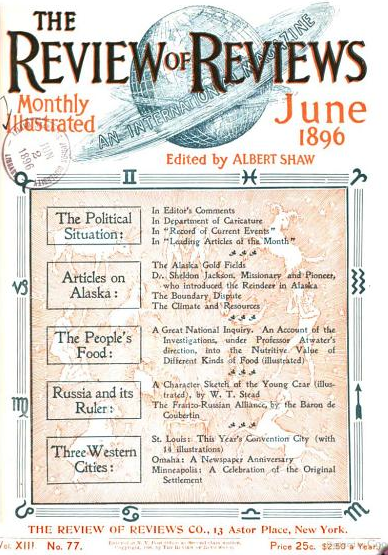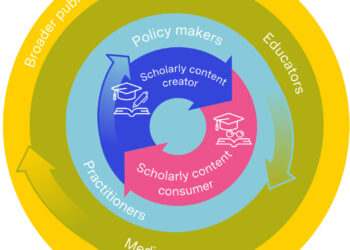 The work that an author creates can look very different when a researcher uses it, a novel property of digital publishing with which we have hardly begun to grapple. Authors’ incentives and objectives shape the creation and dissemination of their scholarship. But while respecting authors’ objectives, the scholarly publisher may at times have a role to reformulate their works to serve additional needs of readers and other users.
The work that an author creates can look very different when a researcher uses it, a novel property of digital publishing with which we have hardly begun to grapple. Authors’ incentives and objectives shape the creation and dissemination of their scholarship. But while respecting authors’ objectives, the scholarly publisher may at times have a role to reformulate their works to serve additional needs of readers and other users.
There are implications of this principle in a number of scholarly publishing forms, but today I want to focus on its application for the review article in particular. In a previous post, I focused on how literature reviews are created, especially the challenges facing an author in seeking comprehensiveness. Here, I will address the needs of the researchers who consult literature reviews and review article, or might wish to do so, following their publication, and some strategies to better serve their needs.
Review articles may appear in any number of different journals, but some journals have long been devoted to the review article or incorporate them systematically. Annual Reviews publishes extensive subfield-specific reviews of the recent literature in 46 fields. Studies in English Literature organizes its quarterly issues into each of four recurring time periods, and each issue includes a review of recent publications pertaining to that time period. The Journal of Economic Literature contains not only regular review articles but also book reviews, a classification system for new books, and an index of dissertations in the field.
In these cases and most others, the review article follows narrative conventions similar to other journal articles. The sources being reviewed are referenced through the same citation system as other articles. Sometimes there is a conclusion or set of recommendations for the field. And ultimately, the article is formatted as a PDF.
In another area, reference, our approach to the publication genre has been systematically rethought since the spread of the internet. While so much of the narrative has focused on Wikipedia and its implications for Encarta, Britannica, and World Book, academic and professional audiences still need and use specialized dictionaries and encyclopedias. These reference works may stand alone through their own digital interfaces as the databases that they naturally are rather than the codices they were once forced to be. And many are also integrated into the Credo Online Reference Service, which provides an integrated discovery and access experience across a variety of underlying works. An editor labors to create The Dictionary of American Regional English, but a graduate student simply finds a definition for an unfamiliar word she has come across in an archive. This is a shift of the greatest importance: the systematic elimination of the book, not only print but electronic as well, from our conceptualization of undertaking a reference task.
How might this line of thinking apply for the literature review? When my former colleague Matthew Long and I wrote about the research practices of academic chemists, we couldn’t help but focus extensively on discovery. In addition to their needs for streamlined current awareness without sacrificing serendipity (which I covered for the Kitchen here), chemists spoke at length about the fantastic resources that are comparatively buried in the traditional form of the literature review.
While compiling the state of a given field is a coherent project on the creation side, delivering this to the researcher in the form of an article assumes a certain type of discovery process. It assumes that a subsequent researcher finds and downloads this journal article and then works through it, presumably in a fairly linear fashion. Valuable for many purposes, absolutely, but for others this may make no more sense than printing a dictionary and binding it as a codex.
Could the review article’s organization and analysis of the field be used to improve discovery in other types of research workflows? There is extensive data implicitly present in such pieces about relationships among publications, which could be useful as a signal that articles are related to one another (offering up the possibility of implicitly curatorial in addition to semantic or usage based recommendations). A review’s annotation and discussion of individual sources would be quite valuable as signals for trust if incorporated in a discovery system, much as book reviews serve for monographs in online bookstores and licensed content platforms. Imagine seeing the one sentence blurb from a neutral scholar while conducting a search, or even the secondary social functionalities that could be developed. We might also find stronger bases for altmetrics than those currently in use.
Repurposing the review article or other literature reviews in these ways would be no small challenge and might be prohibitive retrospectively. But prospectively, publishers should consider opportunities for adding structure to review articles (if not all literature reviews) that would enable them to be reused in other settings. Without diminishing the value in having the review article remain as a standalone output, can we capture the benefits of having access to the analysis they contain in other settings as well?
Discussion
5 Thoughts on "Thinking Through the Lit Review: Part 2: Repackaging the Review Article"
Thanks for this post. When I think of this post in combination with other recent topics on Text and Data Mining, it reminds me that review articles could be pretty powerful in that context. That is, the review article is a narrative that relates its different objects, just as most formal articles; except its objects are often other articles or the assertions/demonstrations in other articles rather than the usual figures and tables.
The review article in my experience often has more references per unit of text than other articles.
If you were to produce a “graphical abstract” of a review article, it might be a diagram of the (highly cited) filtered references connected by the statements about the cited articles.
I wonder how computable the text in a typical review article might be, to capture the assertions and the cluster of references about which an assertion is made and put them together in a structure. Could this new structure then be used/mined to (1) label the articles about which assertions are made — a type of externally-imposed “take home message” — and (2) be used to aid in search-engine based discovery by directing the knowledge graph better through human curation of links. Much as Google puts a box at the top right of many search results.
We know from usage and citation metrics that review articles resonate with users (probably students, librarians and researchers alike). This suggests to me that there’s value that systems — not just users — could make of these dense materials.
If this is already being done or being researched, pointers would be welcome!
John
An issue tree diagram of, or instead of, a review would be a type of graphical abstract of the sort you are describing, John. A review basically presents and explains the various lines of reasoning going on in the subfield being reviewed, based on the referenced articles. Laying out the branching lines of reasoning is just what an issue tree diagram does. The nodes could be the abstracts, or something shorter, also including links to the underlying articles. Or there could be several nodes per article, in order to present the reasoning in the article.
See http://scholarlykitchen.sspnet.org/2013/07/10/the-issue-tree-structure-of-expressed-thought/ and http://scholarlykitchen.sspnet.org/2012/07/17/how-does-science-progress-by-branching-and-leaping-perhaps/. Unfortunately the issue tree diagram of science in the latter article is gone because it links to the DOE OSTI website and that link no longer works.
Whether such a diagram can be computer generated along the lines of TDM I do not know. Given the success of question answering systems like IBM Watson it might be possible. In any case seeing the reasoning going on in a subfield, rather than just reading about it, might be very useful indeed.
Although in general I agree with the point you are making, I think that DARE is not a great example. The online version, http://daredictionary.com, is a pretty interesting resource for linguists with the addition of the original survey data and audio, not to mention the dynamic maps.
This in general gets at the increasing importance of curation. In the Safari service, we’ve added a Tutorial feature which are articles written by subject matter experts on particular topics and provide a path through the underlying content. Not so dissimilar to review articles, although for a less scholarly audience.
And of course in addition to journals there are entire products devoted to this kind of content such as Oxford Bibliographies Online.
It is intriguing to think about trying to automatically mine these kinds of articles to improve discovery and article linking.



